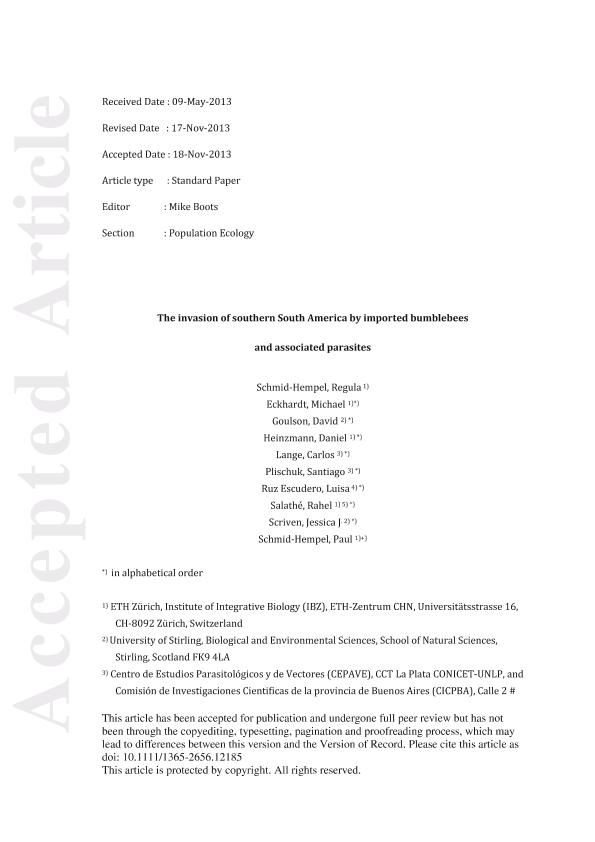Mostrar el registro sencillo del ítem
dc.contributor.author
Schmid Hempel, Regula
dc.contributor.author
Eckhardt, Michael
dc.contributor.author
Goulson, David
dc.contributor.author
Heinzmann, Daniel
dc.contributor.author
Lange, Carlos
dc.contributor.author
Plischuk, Santiago

dc.contributor.author
Escudero, Luisa Ruz
dc.contributor.author
Salathe, Rahel
dc.contributor.author
Scrive, Jessica J.
dc.contributor.author
Schmid Hempel, Paul
dc.date.available
2017-01-06T19:45:40Z
dc.date.issued
2014-07
dc.identifier.citation
Schmid Hempel, Regula; Eckhardt, Michael; Goulson, David; Heinzmann, Daniel; Lange, Carlos; et al.; The invasion of southern South America by imported bumblebees and associated parasites; Wiley; Journal Of Animal Ecology; 83; 4; 7-2014; 823-837
dc.identifier.issn
0021-8790
dc.identifier.uri
http://hdl.handle.net/11336/10945
dc.description.abstract
1. The Palaearctic Bombus ruderatus (in 1982/1983) and Bombus terrestris (1998) have both been introduced into South America (Chile) for pollination purposes. We here report on the results of sampling campaigns in 2004, and 2010–2012 showing that both species have established and massively expanded their range.
2. Bombus terrestris, in particular, has spread by some 200 km year 1 and had reached the Atlantic coast in Argentina by the end of 2011. Both species, and especially B. terrestris, are infected by protozoan parasites that seem to spread along with the imported hosts and spillover to native species.
3. Genetic analyses by polymorphic microsatellite loci suggest that the host population of B. terrestris is genetically diverse, as expected from a large invading founder population, and structured through isolation by distance. Genetically, the populations of the trypanosomatid parasite, Crithidia bombi, sampled in 2004 are less diverse, and distinct from the ones sampled later. Current C. bombi populations are highly heterozygous and also structured through isolation by distance correlating with the genetic distances of B. terrestris, suggesting the latter’s expansion to be a main structuring factor for the parasite.
4. Remarkably, wherever B. terrestris spreads, the native Bombus dahlbomii disappears although the reasons remain unclear. Our ecological and genetic data suggest a major invasion event that is currently unfolding in southern South America with disastrous consequences for the native bumblebee species.
dc.format
application/pdf
dc.language.iso
eng
dc.publisher
Wiley

dc.rights
info:eu-repo/semantics/openAccess
dc.rights.uri
https://creativecommons.org/licenses/by-nc-sa/2.5/ar/
dc.subject
Invasion
dc.subject
Genetics
dc.subject
Pollinator
dc.subject
Chile
dc.subject
Argentina
dc.subject
Patagonia
dc.subject
Bombus
dc.subject
Crithidia
dc.subject
Nosema
dc.subject.classification
Zoología, Ornitología, Entomología, Etología

dc.subject.classification
Ciencias Biológicas

dc.subject.classification
CIENCIAS NATURALES Y EXACTAS

dc.subject.classification
Conservación de la Biodiversidad

dc.subject.classification
Ciencias Biológicas

dc.subject.classification
CIENCIAS NATURALES Y EXACTAS

dc.subject.classification
Ecología

dc.subject.classification
Ciencias Biológicas

dc.subject.classification
CIENCIAS NATURALES Y EXACTAS

dc.title
The invasion of southern South America by imported bumblebees and associated parasites
dc.type
info:eu-repo/semantics/article
dc.type
info:ar-repo/semantics/artículo
dc.type
info:eu-repo/semantics/publishedVersion
dc.date.updated
2016-12-12T14:20:24Z
dc.identifier.eissn
1365-2656
dc.journal.volume
83
dc.journal.number
4
dc.journal.pagination
823-837
dc.journal.pais
Estados Unidos

dc.journal.ciudad
Hoboken
dc.description.fil
Fil: Schmid Hempel, Regula. Eidgenössische Technische Hochschule Zürich; Suiza
dc.description.fil
Fil: Eckhardt, Michael. Eidgenössische Technische Hochschule Zürich; Suiza
dc.description.fil
Fil: Goulson, David. University of Stirling; Reino Unido
dc.description.fil
Fil: Heinzmann, Daniel. Eidgenössische Technische Hochschule Zürich; Suiza
dc.description.fil
Fil: Lange, Carlos. Consejo Nacional de Investigaciones Científicas y Técnicas. Centro Científico Tecnológico La Plata. Centro de Estudios Parasitológicos y de Vectores (i); Argentina. Universidad Nacional de La Plata. Facultad de Ciencias Naturales y Museo; Argentina
dc.description.fil
Fil: Plischuk, Santiago. Consejo Nacional de Investigaciones Científicas y Técnicas. Centro Científico Tecnológico La Plata. Centro de Estudios Parasitológicos y de Vectores (i); Argentina. Universidad Nacional de La Plata. Facultad de Ciencias Naturales y Museo; Argentina
dc.description.fil
Fil: Escudero, Luisa Ruz. Pontificia Universidad Catolica de Valparaiso; Chile
dc.description.fil
Fil: Salathe, Rahel. Eidgenössische Technische Hochschule Zürich; Suiza
dc.description.fil
Fil: Scrive, Jessica J.. University of Stirling; Reino Unido
dc.description.fil
Fil: Schmid Hempel, Paul. Eidgenössische Technische Hochschule Zürich; Suiza
dc.journal.title
Journal Of Animal Ecology

dc.relation.alternativeid
info:eu-repo/semantics/altIdentifier/url/http://dx.doi.org/10.1111/1365-2656.12185
dc.relation.alternativeid
info:eu-repo/semantics/altIdentifier/url/http://onlinelibrary.wiley.com/doi/10.1111/1365-2656.12185/abstract
Archivos asociados
